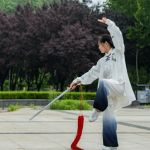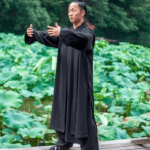Tai Chi Waist Skills
The Importance of the Waist in Tai Chi:
- The waist acts as a bridge between the upper and lower body, serving as the core and connecting link.
- In Tai Chi, movements should form a unified whole, relying on adjustments through the waist.
Concept of ‘Tai Chi Waist’:
- ‘Tai Chi waist’ emphasizes using the waist to drive limb movements, a fundamental principle in martial arts.
- It involves sinking energy to the Dantian, exerting force from the legs but controlling it with the waist.
Role of the Waist in Movement Coordination:
- Initiating movements with the waist guides the limbs and ensures smooth transitions.
- Achieving smooth and flexible movements relies on the waist, not just the hands.
Integration of Hands and Waist:
- While the waist leads movements, the hands play an active role, complementing the waist’s guidance.
- Martial arts emphasize ‘the waist leading the hands,’ highlighting the coordination between both.

Tai Chi Hip Skills
Significance of the Hips in Tai Chi:
- The hips are essential joints in the lower body, serving as the root connecting the waist and legs.
- They play a crucial role in facilitating coordination, energy flow, generating force, bearing weight, and executing martial attacks.
Roles of the Hips:
- Facilitate coordination between upper and lower body.
- Serve as primary gates for energy flow.
- Generate explosive force.
- Bear the body’s weight.
- Act as weapons for martial attacks.
Importance of Relaxed Hips in Tai Chi:
- Relaxed hips are essential for generating internal energy and strength.
- Criteria for relaxed hips include sinking downward, opening circularly, and slight knee bending.
Sensations of Relaxed Hips:
- Body weight feels anchored below the knees.
- Hips can move up and down freely.
- Sense of releasing energy from top to bottom.
- Contraction of the perineum brings inward suction in the hips.
Developing Sensations through Practice:
- Practicing calmly and slowly while paying close attention helps develop a sense of these sensations.

Tai Chi Leg and Foot Skills
Importance of Leg and Foot Techniques in Tai Chi:
- Legs and feet are crucial for promoting longevity and health in Tai Chi practice.
- Strong legs improve deep breathing, lung capacity, and blood circulation, enhancing overall health.
- Tai Chi practitioners with strong legs and stable lower bodies have reduced risk of falling, promoting balance and stability.
Achieving Strong Legs in Tai Chi:
- Begin with ‘Zhuang Gong’ (standing meditation) to master the basics and strengthen leg muscles.
- Practice leg exercises such as ‘Hunyuan Zhuang,’ focusing on Tai Chi principles and maintaining an active stance.
- Shift the center of gravity between different stances, like ‘Bow Stance Zhuang’ and ‘Empty Stance Zhuang,’ to enhance stability and muscle strength.
Understanding Action and Reaction Forces:
- Generate force from the ground by pushing against it, transmitting it through the body to the hands.
- Coordinate movements between the lower, middle, and upper body to master Tai Chi techniques.
Tai Chi Jin (Force) and Yin-Yang Balance:
- Balance yin and yang through stretching and balancing techniques during Zhuang Gong and movements.
- Achieve lightness at the top and stability below, embodying the principle of stretching and balancing yin and yang.
Conclusion
Establishing a Strong Foundation:
- High-level athletes must prioritize building a strong foundation when starting Tai Chi practice.
- Regularly revisiting fundamental skills, even in advanced stages, is crucial for continuous improvement.
Combining Fundamental and Advanced Aspects:
- Integrating foundational techniques with advanced aspects, such as focusing the mind and cultivating energy, is essential.
- This combination ensures smooth flow of movements and expressions between the hands and the gaze.
Avoiding Rushed Learning:
- Rushing into learning routines without dedicating time to fundamental exercises is a common misconception among Tai Chi practitioners.
- Neglecting fundamental exercises significantly affects fitness effectiveness and hampers martial arts improvement.
Integrated Teaching Approach:
- Opt for a combined teaching approach that integrates fundamental exercises into routine teaching.
- This approach enhances students’ interest and ensures improvement in martial arts skills.



